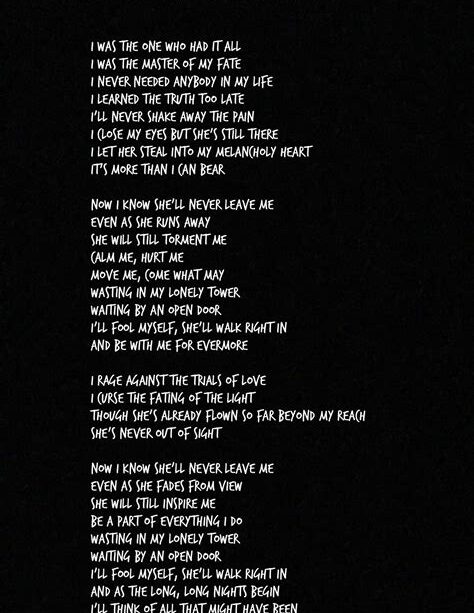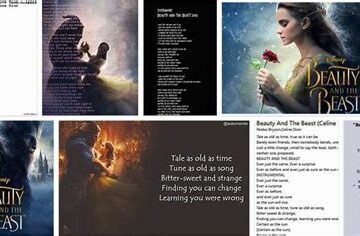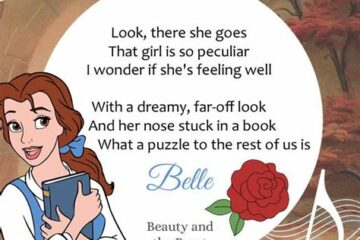
Beauty And The Beast Opening Song Lyrics
Music has always had the power to evoke emotions and captivate listeners in a way that few other art forms can. The opening song of an album or a concert holds a unique significance, setting the stage for what is to come and drawing listeners into the artist’s world. In this blog post, we will dive deep into the intricacies of opening songs, exploring the themes portrayed in their lyrics, the storytelling techniques employed, and the range of emotions they convey. Additionally, we will unravel the enchanting imagery woven into the very fabric of these songs, all of which come together to create a truly unforgettable musical experience.
Understanding the significance of the opening song
When it comes to music, the opening song of an album or a live performance holds a special place. It sets the tone for what is to come and captures the attention of the audience right from the start. The opening song acts as a gateway that welcomes the listeners into the artist’s world and creates a memorable first impression. It serves as an introduction to the album or concert, and can often provide valuable insights into the artist’s intentions and themes.
The opening song of an album or performance plays a crucial role in establishing the atmosphere and mood. It is carefully chosen to grab the listener’s attention and create a sense of anticipation for what lies ahead. Whether it is a fast-paced and energetic track or a slow and introspective ballad, the opening song paves the way for the entire musical journey. It sets the stage for the emotional rollercoaster that the listeners are about to embark on, and can evoke a wide range of feelings.
Analyzing the themes portrayed in the lyrics
When we listen to a song, we often get caught up in the catchy melodies and captivating vocals. However, it is important to also pay attention to the messages and themes portrayed in the lyrics. Lyrics have the power to convey deep emotions, tell captivating stories, and provide social commentary. In this blog post, we will delve into the process of analyzing the themes portrayed in the lyrics of a song, and understand the significance they hold.
A great starting point for analyzing the themes in lyrics is to closely examine the words and phrases used. Pay attention to keywords that are repeated throughout the song, as these often hold significant importance. Look for recurring themes such as love, heartbreak, empowerment, or social issues. By identifying these themes, we can gain a deeper understanding of the song’s intended message.
One effective way to further analyze the themes portrayed in lyrics is to create a list of the different themes present in the song. This helps us organize our thoughts and visually see the different concepts being explored. By breaking down the song into its different themes, we can then focus on each one individually and examine how they are portrayed and developed throughout the song.
| Theme | Description |
|---|---|
| Love | Explore the concept of love and its various forms – romantic, familial, or self-love. |
| Social Issues | Address societal problems such as inequality, discrimination, or environmental concerns. |
| Identity | Reflect on themes of self-discovery, self-acceptance, or personal growth. |
| Hope | Examine themes of optimism, resilience, and finding hope in difficult situations. |
Another important aspect to consider when analyzing the themes in lyrics is to examine the emotions conveyed through the song. Pay attention to the tone, mood, and overall atmosphere created by the lyrics. Does the song evoke feelings of joy, sadness, anger, or nostalgia? Understanding the emotions portrayed in the song can provide further insight into the underlying themes.
By analyzing the themes portrayed in the lyrics of a song, we can gain a deeper appreciation for the artistry and meaning behind the music. Whether it’s exploring themes of love, addressing social issues, or reflecting on personal identity, lyrics have the power to convey powerful messages that resonate with listeners. So, the next time you find yourself captivated by a song, take a moment to analyze the themes within the lyrics, and uncover the hidden layers of meaning that lie beneath the surface.
Exploring the captivating storytelling through music
Music has always been a powerful medium for storytelling, and when combined with captivating lyrics, it creates an unforgettable experience for listeners. The ability of music to transport us to different worlds and evoke a wide range of emotions is truly remarkable. In this blog post, we will delve into the art of storytelling through music, exploring how artists use melody, rhythm, and lyrics to create narratives that captivate and resonate with their audience.
One of the key elements in storytelling through music is the lyrics. Words have a unique ability to convey a story, and when they are set to music, they take on a whole new level of meaning. The use of vivid imagery, metaphors, and storytelling techniques in lyrics can transport listeners to another time or place, allowing them to fully immerse themselves in the narrative. Artists carefully craft their lyrics, choosing words and phrases that evoke specific emotions and paint a vivid picture in the listener’s mind.
Another important aspect of storytelling through music is the melody and rhythm. The melody sets the tone for the story, creating an atmosphere that enhances the lyrics. It can be soft and melancholic, reflecting the emotions of the protagonist, or it can be fast-paced and lively, capturing the excitement of an adventure. The rhythm also plays a crucial role in storytelling, as it dictates the pace and flow of the narrative. By using different musical elements such as tempo changes, instrumental variations, and dynamic shifts, artists can create tension, build suspense, or evoke a sense of resolution, further enhancing the storytelling process.
- Engaging the audience: Music has a unique ability to engage and captivate listeners. It creates a connection between the artist and the audience, allowing them to become part of the story. Whether it’s through relatable lyrics or a catchy melody, music has the power to make the listener feel seen and understood.
- Conveying emotions: Emotions are a fundamental part of any story, and music is a powerful tool for conveying them. Through the use of melody, rhythm, and lyrics, artists can evoke a wide range of emotions in the listener, from joy and excitement to sadness and nostalgia.
- Transporting to different worlds: One of the most enchanting aspects of storytelling through music is its ability to transport listeners to different worlds. Whether it’s through a haunting ballad that takes us back in time or a vibrant anthem that makes us feel like we’re part of a celebration, music allows us to escape reality and experience something entirely new.
In conclusion, exploring the captivating storytelling through music is a journey that takes us to worlds filled with emotions, imagery, and unforgettable narratives. Artists use lyrics, melody, and rhythm to craft stories that resonate with their audience, engaging them on a deep level. From conveying emotions to transporting us to different worlds, music has a way of leaving a lasting impact. So next time you listen to a song, pay attention to the story it tells, and let yourself be carried away by the power of music.
| Benefits of storytelling through music |
|---|
| Engages the audience |
| Conveys emotions |
| Transports to different worlds |
Interpreting the emotions conveyed in the song
Interpreting the Emotions Conveyed in the Song
Music has the power to stir our emotions and leave us in awe of its ability to evoke feelings we may have long forgotten. Each song has its own unique way of impacting our emotions, and interpreting these emotions can bring us closer to understanding the true essence of the song. Whether it be a ballad that tugs at our heartstrings or an upbeat anthem that fills us with joy, the emotions conveyed in a song can leave a lasting impression. In this blog post, we will delve into the art of interpreting the emotions conveyed in a song and explore the various techniques that musicians use to evoke such reactions.
One of the key elements in interpreting the emotions conveyed in a song is paying close attention to the lyrics. Lyrics can be a window into the songwriter’s emotions, allowing us to connect with their experiences on a deeper level. Words or phrases that are repeated throughout the song may signify the importance of a particular emotion or highlight a recurring theme. It is important to analyze the lyrics not only in isolation but also in relation to the melody and rhythm of the song. The way the words are sung and the musical accompaniment can amplify or transform the emotions embedded within the lyrics.
Another aspect to consider when interpreting the emotions conveyed in a song is the use of musical techniques. Dynamics, tempo, and instrumentation all play a crucial role in evoking specific emotional responses from the listener. A sudden change in volume or a shift in tempo can create tension or release within the music, mirroring the emotions being conveyed. The choice of instruments and their timbre can also contribute to the overall emotional atmosphere of the song. For example, a melancholic guitar melody may evoke feelings of nostalgia or longing.
- Repetition of lyrics
- Analyze lyrics in relation to melody and rhythm
- Pay attention to dynamics, tempo, and instrumentation
In addition to lyrics and musical techniques, the context in which a song was written and performed can also influence its emotional impact. The personal experiences and emotions of the songwriter can seep into the composition, making it more relatable and heartfelt. Similarly, the way a song is performed by the singer or band can add a layer of authenticity and intensity to the emotions being conveyed. It is therefore important to consider the background and intentions behind the creation of the song when interpreting its emotional content.
Interpreting the emotions conveyed in a song is an art form in itself. It requires active listening, careful analysis, and an open heart. By paying attention to the lyrics, musical techniques, and the context in which a song was written, we can begin to unravel the myriad of emotions that lie within. So the next time you find yourself captivated by a song, take a moment to delve deeper and explore the vast spectrum of emotions that it carries. You may just discover a whole new level of appreciation for the music that moves you.
| Key Points |
|---|
| Lyrics are a window into the songwriter’s emotions |
| Musical techniques such as dynamics and instrumentation can enhance and transform emotions |
| The context in which a song is written and performed influences its emotional impact |
Unveiling the enchanting imagery in the lyrics
When listening to a song, we often get lost in the rhythm and melody. But have you ever taken a moment to truly appreciate the imagery that is painted through the lyrics? The way words are woven together can create a vivid picture in our minds, evoking emotions and transporting us to another world. In this blog post, we will delve deeper into the topic of unveiling the enchanting imagery in the lyrics.
One of the key aspects of a song that makes it memorable is the imagery it portrays. The use of descriptive language and carefully chosen words can draw the listener into a story, creating a visual experience that resonates long after the song has ended.
Imagery in song lyrics can be presented in various ways. It can be through metaphors, where one thing is compared to another, creating a deeper meaning. For example, when a singer describes a heartache as a “broken glass,” it instantly conveys the intense pain and fragility of a shattered relationship. Imagery can also be conveyed through similes, which use “like” or “as” to make a comparison. These comparisons can take the form of describing a feeling or an experience, making it more relatable to the listener.
Sensory details play a crucial role in creating imagery in lyrics. By using words that appeal to our senses of sight, sound, taste, touch, and smell, songwriters can paint a vivid picture. This allows listeners to connect on a deeper level with the song and its intended emotions. For example, a song about summertime might use words like “sun-kissed,” “beach,” and “ocean breeze” to transport the listener to the warmth and joy of those sunny days.
In conclusion, the enchanting imagery in song lyrics holds tremendous power to captivate our hearts and minds. It brings a song to life, allowing us to connect with the emotions and experiences being conveyed. So next time you listen to a song, take a moment to appreciate the imagery woven within the lyrics and let yourself be transported to a magical world.
Frequently Asked Questions
1. Why is the opening song significant in a movie or TV show?
The opening song sets the tone and mood for the entire experience, creating anticipation and capturing the audience’s attention from the start.
2. What are some common themes portrayed in the lyrics of opening songs?
Common themes include love, friendship, self-discovery, overcoming obstacles, and resilience.
3. How does storytelling through music enhance the overall viewing experience?
Storytelling through music adds depth and emotional impact to the narrative, allowing the audience to connect with the characters and their journeys on a more profound level.
4. How can the emotions conveyed in the opening song impact the viewer or listener?
The emotions conveyed in the opening song can create a strong emotional connection, evoke nostalgia, excitement, or even anticipation, enhancing the overall experience and drawing the viewer or listener deeper into the story.
5. What kind of imagery can be found in the lyrics of opening songs?
The imagery in opening song lyrics can range from vivid descriptions of landscapes, characters, or events to symbolic language that captures the essence of the story or sets a specific mood.
6. Can you give examples of how specific emotions are conveyed through music in opening songs?
A somber melody and mournful lyrics can convey sadness or loss, while an upbeat tempo and catchy lyrics can evoke joy and excitement. The specific musical elements, such as key, chord progressions, and instrumentation, also play a role in conveying emotions.
7. How does the opening song contribute to the overall success and popularity of a movie or TV show?
The opening song can serve as a memorable and recognizable theme that becomes closely associated with the movie or TV show. It can create a strong first impression, generating buzz and anticipation among viewers, and even becoming an iconic element of pop culture.
Top 10 Disney Characters You Didn’t Know About
December 30, 2024A Deep Dive Into Disney Princesses And Their Stories
December 29, 2024The Meaning Behind Beauty And Beast Lyrics
December 29, 2024Why Beauty And The Beast Is A Timeless Disney Classic
December 29, 2024The Role Of Disney Princesses In Modern Culture
December 29, 2024Exploring The Themes In Beauty And The Beast Lyrics
December 28, 2024
Leave a reply Cancel reply
Recommended
-
My Beauty And The Beast Lyrics
November 16, 2021 -
Stevie Nicks Beauty And The Beast Lyrics
August 21, 2023 -
Top 10 Beauty and the Beast Cartoon Episodes You Need to Watch
September 26, 2023









